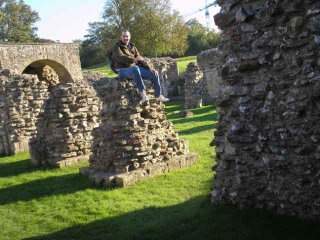St. Augustine's Monastery
When I was in Canterbury over the weekend, I got to visit the ruins of St. Augustine's monastery. (That's Augustine of Canterbury, not to be confused with my hero Augustine of Hippo.) They let you walk around the ruins, and you get this little headset of narrative of what stuff is. They also included this audio bit about what life was like for a monk, and it had all these sound effects to listen to as you walked through the ruins.  Having been involved in radio before, I was impressed at the part where you walk into the old altar area and the audio guide played the entire Matins office in chant while you stand there amongst the old monastic chapel.
Having been involved in radio before, I was impressed at the part where you walk into the old altar area and the audio guide played the entire Matins office in chant while you stand there amongst the old monastic chapel. 
 I was especially fond of this shot. A flower among the ruins. There's a sermon in there somewhere.
I was especially fond of this shot. A flower among the ruins. There's a sermon in there somewhere.
 This picture shows you the progressive enlargement of the monastery. I am standing in the original chapel (now below ground level) and the Norman and further expansions go on up the hill.
This picture shows you the progressive enlargement of the monastery. I am standing in the original chapel (now below ground level) and the Norman and further expansions go on up the hill.  This picture with the stone pillars was the final worship area of the monastery before Henry VIII managed to tear it all up within 2 years and turn it into a personal estate. Apparently most of the bricks from the actual chapel and monastery were sold to villagers a ha'penny for two dozen. The abbot received 100 pounds and was able to remain on the property as a gardener until his death. The other monks (over 100) were given a severence of 5 pounds and turned out into the street. The older ones were forced to become beggars.
This picture with the stone pillars was the final worship area of the monastery before Henry VIII managed to tear it all up within 2 years and turn it into a personal estate. Apparently most of the bricks from the actual chapel and monastery were sold to villagers a ha'penny for two dozen. The abbot received 100 pounds and was able to remain on the property as a gardener until his death. The other monks (over 100) were given a severence of 5 pounds and turned out into the street. The older ones were forced to become beggars.
 Having been involved in radio before, I was impressed at the part where you walk into the old altar area and the audio guide played the entire Matins office in chant while you stand there amongst the old monastic chapel.
Having been involved in radio before, I was impressed at the part where you walk into the old altar area and the audio guide played the entire Matins office in chant while you stand there amongst the old monastic chapel. 
Here's a cameo appearance by the big man himself, or at least his grave. Once one of the most hollowed pilgrimage sites in all of England, Henry had the shrine destroyed and this simple marker placed over his grave.
 I was especially fond of this shot. A flower among the ruins. There's a sermon in there somewhere.
I was especially fond of this shot. A flower among the ruins. There's a sermon in there somewhere. This picture shows you the progressive enlargement of the monastery. I am standing in the original chapel (now below ground level) and the Norman and further expansions go on up the hill.
This picture shows you the progressive enlargement of the monastery. I am standing in the original chapel (now below ground level) and the Norman and further expansions go on up the hill.  This picture with the stone pillars was the final worship area of the monastery before Henry VIII managed to tear it all up within 2 years and turn it into a personal estate. Apparently most of the bricks from the actual chapel and monastery were sold to villagers a ha'penny for two dozen. The abbot received 100 pounds and was able to remain on the property as a gardener until his death. The other monks (over 100) were given a severence of 5 pounds and turned out into the street. The older ones were forced to become beggars.
This picture with the stone pillars was the final worship area of the monastery before Henry VIII managed to tear it all up within 2 years and turn it into a personal estate. Apparently most of the bricks from the actual chapel and monastery were sold to villagers a ha'penny for two dozen. The abbot received 100 pounds and was able to remain on the property as a gardener until his death. The other monks (over 100) were given a severence of 5 pounds and turned out into the street. The older ones were forced to become beggars.

Comments